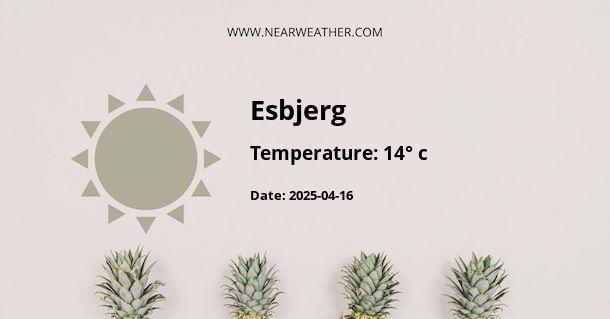Climate and Weather in Esbjerg, Denmark
Esbjerg, located in Denmark, experiences a temperate maritime climate with cool summers and mild winters. The city is situated on the west coast of Jutland, which is known for its beautiful coastal landscapes. Let's take a closer look at the climate and weather patterns in Esbjerg throughout the year.
Temperature
The average annual temperature in Esbjerg is around 8.5 degrees Celsius (47.3 degrees Fahrenheit). Summers in Esbjerg are generally cool, with average temperatures ranging from 15 to 20 degrees Celsius (59 to 68 degrees Fahrenheit). The warmest month is usually July, with average highs reaching around 20 degrees Celsius (68 degrees Fahrenheit).
Winters in Esbjerg are mild, with average temperatures ranging from 0 to 5 degrees Celsius (32 to 41 degrees Fahrenheit). The coldest month is typically January, with average lows around 0 degrees Celsius (32 degrees Fahrenheit).
It is important to note that temperatures can vary from year to year, and extreme weather events can occur. It is always advisable to check the local weather forecast before planning any outdoor activities.
Precipitation
Esbjerg experiences moderate rainfall throughout the year, with an average annual precipitation of around 700 millimeters (27.6 inches). The wettest months are generally August and October, while the driest month is typically February.
The city also receives a fair amount of snowfall during the winter months, with an average of 20-30 snowy days per year. Snowfall can create beautiful winter scenery in Esbjerg, but it can also affect transportation and outdoor activities.
Sunshine Hours
Esbjerg enjoys a moderate amount of sunshine throughout the year. The city receives an average of 1,700 hours of sunshine annually, which is relatively high compared to other regions in Denmark. The sunniest months are typically May and June, with an average of 8-9 hours of sunshine per day.
Wind
Due to its coastal location, Esbjerg experiences strong winds throughout the year. The prevailing winds come from the southwest, bringing in cool air from the North Sea. Wind speeds can reach an average of 8-10 meters per second (18-22 miles per hour), with occasional gusts during stormy weather.
Climate Graph
The following climate graph provides a visual representation of the average monthly temperatures and precipitation in Esbjerg:
| Month | Temperature (°C) | Precipitation (mm) |
|---|---|---|
| January | 2 | 50 |
| February | 2 | 35 |
| March | 4 | 40 |
| April | 7 | 35 |
| May | 12 | 40 |
| June | 15 | 45 |
| July | 17 | 65 |
| August | 17 | 80 |
| September | 14 | 55 |
| October | 10 | 75 |
| November | 6 | 60 |
| December | 3 | 55 |
Note: The temperatures and precipitation values in the table are approximate averages and can vary from year to year.
Severe Weather
While Esbjerg generally experiences mild weather conditions, it is important to be aware of potential severe weather events. Storms, heavy rain, and high winds can occur throughout the year, especially during the autumn and winter months. It is recommended to stay updated with weather forecasts and follow any instructions or warnings issued by local authorities.
Conclusion
Esbjerg's climate is characterized by cool summers, mild winters, and moderate rainfall throughout the year. The city enjoys a moderate amount of sunshine and is known for its strong coastal winds. Whether you visit Esbjerg for its beautiful beaches or its cultural attractions, it is always wise to be prepared for changing weather conditions and stay informed about local forecasts.
A - Esbjerg's Latitude is 55.466671 & Longitude is 8.450000.
A - Weather in Esbjerg is 9° today.
A - Climate Conditions in Esbjerg shows broken clouds today.
A - Humidity in Esbjerg is 91% today.
A - Wind speed in Esbjerg is 33.34 km/h, flowing at 240° wind direction. today.
